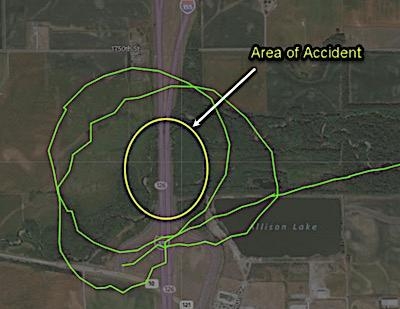Information Included In Preliminary Report From March 3 Accident
The NTSB has released a preliminary report from an accident that occurred March 3 in Lincoln, IL which fatally injured a commercially-rated pilot and two passengers.

The three were aboard a Cessna 172S that was engaged in an aerial survey of a bald eagle nest near Lincoln. Shoener Environmental contacted Synergy Flight Center and coordinated with the pilot to conduct several flights. Shoener Environmental reported the purpose of the aerial survey was to aid in the environmental assessment of potential wind turbine installations in the area. At the time of the accident, the pilot was employed as the chief flight instructor at Synergy Flight Center, however he was also employed as a regional airline pilot.
Synergy Flight Center conducted the first aerial survey flight with Shoener Environmental on February 29, 2020 and the second aerial survey flight occurred on March 2, 2020. The first two flights were conducted with another flight instructor from Synergy Flight Center. For the accident flight, the owner reported the pilot was flying with two ecologists from Shoener Environmental and the ecologists would use cameras to document the bald eagle nest. Prior to the flight, the pilot requested to line service personnel that the airplane be "topped off" with fuel. Synergy Flight Center completed putting 27.8 gallons of 100 low lead fuel in the airplane at 0759.
A preliminary review of L3Harris Technologies OpsVue track data showed that after departure at 0804, the airplane traveled south near Le Roy, Illinois, before traveling southwest near Heyworth, Illinois. The airplane continued a southwest path toward Lincoln. To the northwest of Lincoln, the airplane entered a right-hand descending turn, orbiting around a heavily wooded area that is intersected by the Kickapoo Creek and highway I-55. The track data showed that during the turn, the airplane was losing altitude, losing ground speed, and the track data was lost at 0846. The last track data indicated the airplane was about 1,075 ft msl, at an estimated ground speed of 50 kts, and was traveling to the southwest.
The airplane impacted the southbound lanes of the interchange of I-55 and state routes 10 and 121. A postimpact fire ensued and fire fighters utilized water to extinguish the fire. There were no injuries to any personnel on the ground. A postaccident examination of the airframe and engine found no preimpact mechanical malfunctions or failures. The postaccident examination of the wreckage did not reveal evidence of a bird strike or snarge.
Postaccident testing by Synergy Flight Center of their fueling system at the Central Illinois Regional Airport (BMI), Bloomington, Illinois, found no abnormalities with their 100 low lead fuel.
A preliminary review of weather data prior to and at the time of the accident found no evidence of low-level wind shear occurring near the accident site at the altitude the airplane was performing the orbiting turn.
The four-seat airplane was equipped with a Garmin G1000 all-glass avionics suite and a stall warning system. The Cessna 172S Pilot's Operating Handbook states that the stall speed (power off) for the flaps up position is 53 kts calibrated airspeed (KCAS) and for the flaps down position is 48 kts KCAS. This document further discusses stalls and states in part:
The stall characteristics are conventional and aural warning is provided by a stall warning horn which sounds between 5 and 10 knots above the stall in all configurations.
The Aircraft Owners and Pilots Association Air Safety Foundation has published Safety Advisor (Operations and Proficiency Number 8) Maneuvering Flight – Hazardous to your Health? This document discusses aerial work and states in part:
Aerial work includes photography, pipeline patrol, banner towing, and crop dusting. These activities require a significant division-of-attention at low altitudes. Pilots performing aerial work are generally highly qualified and use excellent judgment. But, if something goes wrong, there is little time to recover.
(Image provided with NTSB Preliminary Report)
 Unfortunate... ANN/SportPlane Resource Guide Adds To Cautionary Advisories
Unfortunate... ANN/SportPlane Resource Guide Adds To Cautionary Advisories ANN FAQ: Turn On Post Notifications
ANN FAQ: Turn On Post Notifications ANN's Daily Aero-Term (04.29.24): Visual Approach Slope Indicator (VASI)
ANN's Daily Aero-Term (04.29.24): Visual Approach Slope Indicator (VASI) ANN's Daily Aero-Term (04.28.24): Airport Marking Aids
ANN's Daily Aero-Term (04.28.24): Airport Marking Aids ANN's Daily Aero-Linx (04.28.24)
ANN's Daily Aero-Linx (04.28.24)



